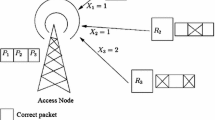Abstract
This paper proposes Lossy-Forwarding Hybrid Automatic Repeat reQuest (LF-HARQ) schemes to improve bit-error-rate, packet-error-rate and throughput performances of dual-hop wireless parallel relaying systems. In contrast to the conventional lossless decode-and-forward schemes, where erroneous packets are always discarded at the relay, we introduce Lossy-Forwarding concept to HARQ technique that allows the relay nodes to forward them to the next hop, referred to as Fully LF-HARQ (FLF-HARQ) scheme. We then propose Partially LF-HARQ (PLF-HARQ) scheme, where the relaying nodes select either forwarding the erroneous packets or requesting retransmission. The mode selection is based on the confidence indicator (CI) expressing the reliability of the received packets. Since the channels are assumed to suffer from block Rayleigh fading, the CI is calculated via online measurement of mutual information, block-by-block. Results of computer simulations to verify the superiority of the proposed techniques are presented.








Similar content being viewed by others
Notes
Compared with CRC, CI has capability of identifying multiple levels of reliability of the entire one block packet.
DA is a rate-1 systematic recursive convolutional code where every \(\rho \)th systematic bits is replaced with the accumulated coded bits [13].
In this sense, the EXIT Chart analysis provided in this section is based on [19] projection technique.
The theoretical bound for BER is not shown in Fig. 6 because it is difficult to calculate since the coding structure should be considered.
References
Wu, H., Qiao, C., De, S., & Tonguz, O. (2001). Integrated cellular and ad hoc relaying systems: iCAR. IEEE Journal on Selected Areas in Communications, 19(10), 2105–2115.
Li, Y., Rahman, M., Ng, S. X., & Vucetic, B. (2013). Distributed soft coding with a soft input soft output (SISO) relay encoder in parallel relay channels. IEEE Transactions on Communications, 61(9), 3660–3672.
Wiemann, H., Meyer, M., Ludwig, R., & O, C. P. (2005). A novel multi-hop ARQ concept. In 2005 IEEE 61st vehicular technology conference, 2005. VTC 2005-Spring (pp. 3097–3101).
Jeon, S. Y., Han, K. Y., Suh, K., & Cho, D. H. (2007). An efficient ARQ mechanism in multi-hop relay systems based on IEEE 802.16 OFDMA. In 2007 IEEE 66th vehicular technology conference, 2007. VTC-2007 Fall (pp. 1649–1653).
Jeon, S. Y., & Cho, D. H. (2008) Modelling and analysis of ARQ mechanisms for wireless multi-hop relay system. In Vehicular technology conference, 2008. VTC Spring 2008 (pp. 2436–2440). IEEE.
Tabet, T., Dusad, S., & Knopp, R. (2005) Achievable diversity-multiplexing-delay tradeoff in half-duplex ARQ relay channels. In Proceedings of the international symposium on information theory, 2005. ISIT 2005 (pp. 1828–1832).
Chiarotto, D., Simeone, O., & Zorzi, M. (2010) Throughput and energy efficiency of opportunistic routing with Type-I HARQ in linear multihop networks. In Global telecommunications conference (GLOBECOM 2010) (pp. 1–6). IEEE.
Fu, W., Tao, Z., Zhang, J., & Agrawal, D. (2009). Error control strategies for WiMAX multi-hop relay networks. In Global telecommunications conference, 2009. GLOBECOM 2009 (pp. 1–6). IEEE.
Kim, S. H., & Jung, B. C. (2014). On the optimal link adaptation in linear relay networks with incremental redundancy HARQ. IEEE Communications Letters, 18(8), 1411–1414.
Levorato, M., Librino, F., & Zorzi, M. (2011). Integrated cooperative opportunistic packet forwarding and distributed error control in MIMO ad hoc networks. IEEE Transactions on Communications, 59(8), 2215–2227.
Zhao, B., & Valenti, M. (2005). Practical relay networks: A generalization of hybrid-ARQ. IEEE Journal on Selected Areas in Communications, 23(1), 7–18.
Bhamri, A., Kaltenberger, F., Knopp, R., & Hamalainen, J. (2011). Smart hybrid-ARQ (SHARQ) for cooperative communication via distributed relays in LTE-Advanced. In 2011 IEEE 12th international workshop on signal processing advances in wireless communications (SPAWC) (pp. 41–45).
Anwar, K., & Matsumoto, T. (2012). Accumulator-assisted distributed turbo codes for relay systems exploiting source-relay correlation. IEEE Communications Letters, 16(7), 1114–1117.
Irawan, A., Anwar, K., & Matsumoto, T. (2013). Combining-after-decoding turbo hybrid ARQ by utilizing doped-accumulator. IEEE Communications Letters, 17(6), 1212–1215.
Irawan, A., Anwar, K., & Matsumoto, T. (to be published). Lossy forwarding techniques for parallel multihop-multirelay systems. In 2015 IEEE 82nd vehicular technology conference, 2015. VTC-2015 Fall.
Wolf, A., Matthe, M., & Fettweis, G. (2015). Improved source correlation estimation in wireless sensor networks. In IEEE ICC 2015-workshop on advanced PHY and MAC technique for super dense wireless networks.
Hagenauer, J. (2004). The EXIT chart: Introduction to extrinsic information transfer in iterative processing. In European signal processing conference (pp. 1541–1548).
ten Brink, S. (2001). Convergence behavior of iteratively decoded parallel concatenated codes. IEEE Transactions on Communications, 49(10), 1727–1737.
Irawan, A., Anwar, K., & Matsumoto, T. (2013). Low complexity time concatenated turbo equalization for block transmission without guard interval: Part 3–application to multiuser SIMO-OFDM. Wireless Personal Communications, 70(2), 769–783.
Acknowledgments
This work has been performed in the framework of the FP7 project ICT-619555 RESCUE (Links-on-the-fly Technology for Robust, Efficient and Smart Communication in Unpredictable Environments) which is partly funded by the European Union. This work has been also supported in part under JSPS Kakenhi Grant No. 26289119.
Author information
Authors and Affiliations
Corresponding author
Additional information
Khoirul Anwar: On leave to Telkom University, Jl. Telekomunikasi Terusan Buah Batu, Bandung 40257, Indonesia.
Rights and permissions
About this article
Cite this article
Irawan, A., Anwar, K. & Matsumoto, T. Lossy Forwarding HARQ for Parallel Relay Networks. Wireless Pers Commun 95, 915–930 (2017). https://doi.org/10.1007/s11277-016-3805-8
Published:
Issue Date:
DOI: https://doi.org/10.1007/s11277-016-3805-8




